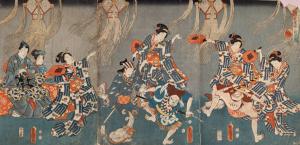From the Genji Twelve Months: the Beginning of Autumn (Genji Jūnikagetsu no Uchi, Mōshū)
Painted by Utagawa Toyokuni III 1856 (Ansei 3) Tokyo Shiryō Collection 07761-C3
Moshu (the beginning of autumn) refers to the seventh month of the lunar calendar and this color print features an annual Bon odori festival that takes place in this month. The print depicts a scene of the Bon Festival. Women dance in matching kimonos at the feet of kiriko doro, multifaceted Bon lanterns.
The Bon Festival was originally a Buddhist ceremony. It is said that in the Heian period, the nenbutsu odori (dancing with prayers accompanied by drum beating) started by Koya Shonin was connected to the Urabon (the Feast of Lanterns) and the departed souls were received to repose them. It is also said that in the beginning of the Muromachi period, the drum performances and dancing seen today began.
In the Edo period, the religious connection to the event gradually weakened and it became more to do with popular entertainment. In the Enpo period (1673 to 1681), the gaudiness of the festival became such that the shogunate banned it.
During the Bon Festival, people danced in a circle around yaguras (scaffolding) which was known as 'Wa-odori' and there was also 'Komachi odori' where dancers strolled through the streets. As this took place on the fifteenth day of the seventh month of the lunar calendar, it seems that the Bon Festival always took place under a full moon.


